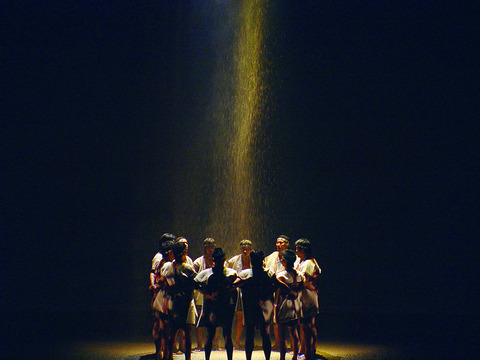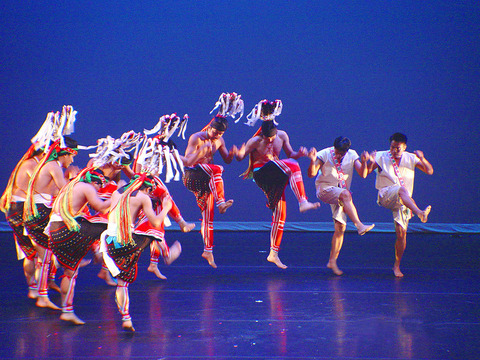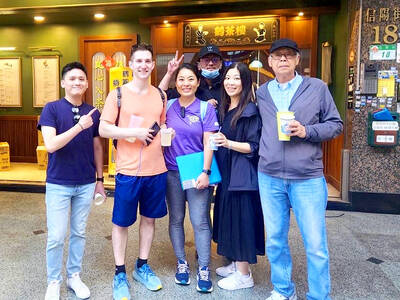With their imminent move to a new base in Hualien County, it will probably be a long while before Taiwan's foremost Aboriginal troupe, the Formosa Aboriginal Song and Dance Troupe (原舞者), stages another production in Taipei. This weekend's performances at the Novel Hall (新舞台) will also be a celebration of 15 years of endeavoring to preserve Taiwan's Aboriginal ritual traditions. The troupe will present the finest of the traditional songs and dances from six tribes epitomizing the multifarious tribal cultures and social changes that Taiwan's Aboriginal societies have undergone in their long history.
Aiming to preserve and revive the fast disappearing tribal songs and dances, the company was established by a group of young Aboriginals from different tribes in 1991. Part of their goal was to reverse the public's perception that Aboriginal dance was simply a tourist spectacle, bringing out the great ritual and social significance that these acts represent.
Over the years, the company not only has staged hundreds of performances touring around the country, but also holds workshops to re-ignite the interest of young Aboriginals' in traditional dance culture through reinterpretations and integration with contemporary theatrical elements. The troupe has gained considerable international recognition and has performed at art festivals in the US, Belgium, UK, Germany, France, Spain, Singapore and Hong Kong.

PHOTOS COURTESY OF FORMOSA ABORIGINAL SONG AND DANCE TROUPE
Each production is based on long-term field observations and participation. Assisted by anthropologists and tribal elders, troupe members and Aboriginal students are dispatched to different villages to study their rituals through the oral tradition. According to artistic director Faidaw Fangod, the duration of each visit to a village is limited to 10 days, to avoid disturbing the tribal life and traditions of their hosts.
“Take the Saisiyat tribe (賽夏族) for example. Their ceremonial songs and dances are regarded as sacred and there is a prohibition on public performance. Teaching outsiders like us thus poses a big challenge to them. We spent lots of time communicating with local residents until the tribal leaders agreed to let us study the rituals after many private meetings,” Fangod explained.
Since Aboriginal tribes exhibit great diversity in terms of language, culture and ritual, one of the biggest challenges for troupe members is to overcome the language barrier. “The tribes' phonic systems differ greatly and there is no unifying model for pronunciation. It's a painstaking task to learn the languages, let alone to familiarize oneself with the diverse ways of singing in different tribes,” said Fangod, an Amis from Taitung.

Featured in the current show is the highly acclaimed 1991 production of Legend of Mountains and Seas featuring the mayasvi ritual from the Tufuya village of the Tsou tribe (鄒族), who live deep in the mountains, and the ilisin ceremony from the coastal Amis tribe (阿美族).
Containing well-preserved ancient language elements whose meaning is no longer fully comprehensible, the mayasvi is a sacred ritual held each year after millet harvest to plead for gods' blessing on the tribe's solidarity, exorcising the evil spirits and paying respects to the dead. The Amis ilisin ritual is held at the end of each year to express gratitude to ancient spirits and supernatural powers. The event is always boisterous since Amis believes the grander the ceremony, the better the harvest in the coming year.
As for their own uncertain future in Hualien, the company's founder remains optimistic and positive. “It's a change of direction. We get to return to our lands and peoples and continue our work to preserve and pass down our cultural heritages,” said Fangod.

A vaccine to fight dementia? It turns out there may already be one — shots that prevent painful shingles also appear to protect aging brains. A new study found shingles vaccination cut older adults’ risk of developing dementia over the next seven years by 20 percent. The research, published Wednesday in the journal Nature, is part of growing understanding about how many factors influence brain health as we age — and what we can do about it. “It’s a very robust finding,” said lead researcher Pascal Geldsetzer of Stanford University. And “women seem to benefit more,” important as they’re at higher risk of

Eric Finkelstein is a world record junkie. The American’s Guinness World Records include the largest flag mosaic made from table tennis balls, the longest table tennis serve and eating at the most Michelin-starred restaurants in 24 hours in New York. Many would probably share the opinion of Finkelstein’s sister when talking about his records: “You’re a lunatic.” But that’s not stopping him from his next big feat, and this time he is teaming up with his wife, Taiwanese native Jackie Cheng (鄭佳祺): visit and purchase a

Experts say that the devastating earthquake in Myanmar on Friday was likely the strongest to hit the country in decades, with disaster modeling suggesting thousands could be dead. Automatic assessments from the US Geological Survey (USGS) said the shallow 7.7-magnitude quake northwest of the central Myanmar city of Sagaing triggered a red alert for shaking-related fatalities and economic losses. “High casualties and extensive damage are probable and the disaster is likely widespread,” it said, locating the epicentre near the central Myanmar city of Mandalay, home to more than a million people. Myanmar’s ruling junta said on Saturday morning that the number killed had

Mother Nature gives and Mother Nature takes away. When it comes to scenic beauty, Hualien was dealt a winning hand. But one year ago today, a 7.2-magnitude earthquake wrecked the county’s number-one tourist attraction, Taroko Gorge in Taroko National Park. Then, in the second half of last year, two typhoons inflicted further damage and disruption. Not surprisingly, for Hualien’s tourist-focused businesses, the twelve months since the earthquake have been more than dismal. Among those who experienced a precipitous drop in customer count are Sofia Chiu (邱心怡) and Monica Lin (林宸伶), co-founders of Karenko Kitchen, which they describe as a space where they